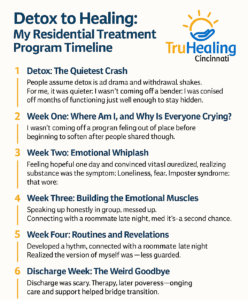When I checked into residential treatment, I felt like I had a neon sign above my head that screamed, “I don’t belong here.” I wasn’t “falling apart” in the way I thought you had to be. I had a job. I was decent at faking it. But I was falling apart quietly, and I couldn’t do it anymore.
No one talks enough about how weird it feels to be young and sober, especially when your friends are still out there living in “work hard, play hard” land. I felt out of place everywhere—including at the start of treatment. But day by day, that shifted.
Here’s what my residential treatment program timeline looked like—awkward moments, unexpected breakthroughs, and the real stuff in between. If you’re considering a residential treatment program in Cincinnati, this might give you a sense of what’s ahead.
1. Detox: The Quietest Crash
People assume detox is all drama and withdrawal shakes. For me, it was quieter. I wasn’t coming off a bender; I was coming off months (years?) of functioning just well enough to stay hidden.
Detox was my first taste of stillness. Nurses checked my vitals. I was given space, rest, and food I didn’t have to cook. The fog started to lift slowly. I was physically safe, but emotionally raw.
That was the point.
2. Week One: Where Am I, and Why Is Everyone Crying?
The first week of actual programming was like walking into someone else’s dream. I didn’t get the group lingo. I didn’t know when to share or how honest to be. I kept thinking, “They seem worse than me.” (Spoiler: comparison is just another form of denial.)
Still, something softened in me. It was the first time I heard people say things out loud that I only whispered in my own head. That cracked something open.
3. Week Two: Emotional Whiplash
One day I was feeling hopeful, the next I was convinced I’d failed already. I cried more in week two than I had in years—but I also laughed. Deep, belly laughs with people I barely knew.
We wrote timelines, explored triggers, and unpacked belief systems. This wasn’t just about not using; it was about figuring out what I’d been using to cover.
That realization hit hard: substance was the symptom. Loneliness, fear, imposter syndrome? Those were the disease.
4. Week Three: Building the Emotional Muscles
This was the week I stopped shrinking myself. I stopped muting my story so it wouldn’t seem “less bad” than others. I stopped trying to intellectualize everything.
I also messed up in group once. I said something dismissive, not realizing how it would land. We unpacked it. I owned it. And instead of getting kicked out (my worst fear), I got a hug and a second chance.
Turns out, growth isn’t clean. It’s messy, embarrassing, and worth it.

5. Week Four: Routines and Revelations
By week four, I had a rhythm. I knew the group flow. I wasn’t terrified of vulnerability. We role-played boundaries (cringy, but useful). I started journaling without an assignment. One night I stayed up late talking with a roommate about the version of ourselves we wanted to meet on the other side of this.
That version wasn’t some hyper-productive, perfect adult. It was just us—less guarded, more real.
6. Discharge Week: The Weird Goodbye
You’d think discharge would feel triumphant. Honestly, it was mostly scary. I had tools. I had a plan. But the structure was falling away. I was going back into a world that didn’t revolve around recovery.
Luckily, I had next steps—therapy lined up, alumni support, and ongoing care. If you’re near Lexington, Kentucky or Springfield, Ohio, TruHealing Cincinnati has options that bridge that transition.
The goal wasn’t perfection. It was continuation.
7. Three Months Later: Still Awkward, Still Sober
Real talk: I didn’t leave treatment “fixed.” But I left more honest. I started being the friend who says no to that third drink. The one who leaves the party when it stops being fun. The one who chooses awkward honesty over silent spirals.
That’s what residential treatment gave me. Not a new personality—but access to the version of myself I kept hiding under the mask of “I’m fine.”
FAQ: Residential Treatment, Demystified
How long is a residential treatment program at TruHealing Cincinnati?
Most programs last 30 to 45 days, but lengths can vary depending on your needs and insurance. You’ll work with a treatment team to determine what’s right for you.
What’s the difference between detox and residential treatment?
Detox is the medical process of safely clearing substances from your body. Residential treatment comes after—it focuses on therapy, recovery skills, and emotional healing.
Do I have to hit rock bottom to qualify?
No. Residential care isn’t just for people in crisis. If you’re using more than you want to, feeling out of control, or simply exhausted, that’s reason enough.
Can I still work or go to school during treatment?
Residential programs are immersive and typically require full-time participation. But if you need a flexible option later, ask about outpatient or step-down services.
Is it weird to be young and in treatment?
Honestly? Sometimes, yes. But that passes. The weirdness fades the moment you realize you’re not alone—and you don’t have to pretend anymore.
Ready to Take the First Step?
Call (888) 643-9118 to learn more about our residential treatment program services in Cincinnati, Ohio. Whether you’re feeling totally lost or just tired of pretending, there’s space for you here.

